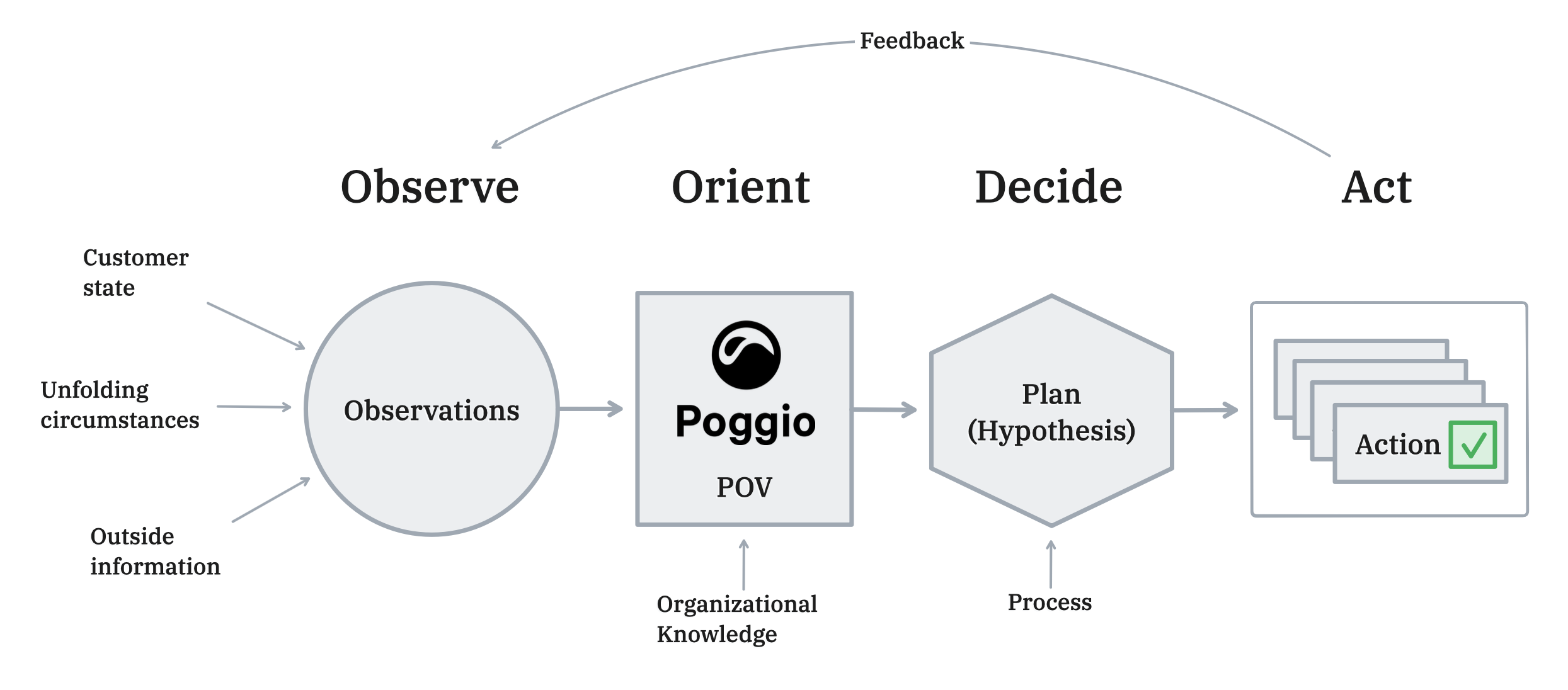Imagine a revenue organization that operates with the speed and precision of a Formula 1 pit crew. Customer needs are anticipated before they're expressed. Market shifts trigger real-time responses. Every touchpoint carries deep personalization, every interaction draws from comprehensive intelligence, and every decision reflects complete customer context.
While today's agentic systems are evolving rapidly, this vision represents where our industry is going. The word "agentic" defies a universal definition, but it describes something fundamentally different from today's sales automation tools: AI systems that exhibit adaptive behavior, and operate for longer periods of time with minimal human oversight. Rather than executing predefined workflows, they observe, “reason,” make plans, and perform actions in response to changing conditions.
The coming agent transformation promises organizations that are simultaneously more human and more efficient. More human because sellers will be able to focus on high-value relationship building rather than administrative work. More efficient because intelligent systems handle the complex orchestration of customer intelligence, planning, and execution at scale.
How quickly can we prepare our organizations and build the technical foundations that makes this all possible? The answer lies in understanding how autonomous systems achieve reliable operation and applying those principles to revenue operations today.
The OODA loop, a framework for autonomous operation
The OODA loop (Observe, Orient, Decide, Act) was developed by military strategist John Boyd to describe how fighter pilots make split-second decisions in dynamic, high-stakes environments. The framework has since spread across domains from autonomous robotics to competitive strategy, wherever rapid, intelligent response to changing conditions is critical.
In autonomous systems, such as robots, OODA provides a framework for structured decision-making under uncertainty. Sensors observe the environment. Processing systems orient raw data into meaningful contextual understanding. Planning algorithms decide on optimal actions. Actuators execute those decisions. The cycle repeats continuously, with each iteration informed by feedback from previous actions and their results.
For revenue organizations, OODA offers a powerful framework for building modern autonomous systems of intelligent customer engagement. Instead of static account plans and periodic reviews, imagine revenue organizations that continuously observe customer signals, orient this information within strategic context, decide on optimal approaches, and act to strengthen relationships and advance opportunities.

This continuous loop creates what we call "customer state awareness", complete, real-time, fact-based beliefs about where each account stands, where they want to go, and how your organization helps them get there. Let’s explore each phase of the OODA loop to unpack how things fit together from a revenue operations perspective.
Observe: always-on intelligence
Any agentic system starts with comprehensive observation. In the context of revenue organizations, this means establishing a means of always-on intelligence that proactively gathers information and detects novel changes across your customers and prospects.
Traditional account research happens in discrete bursts. For example, before sales kick offs, to prep for quarterly business reviews, ahead of renewal discussions, or when pursuing new opportunities. Or the day before the deadline your boss set for account plan completion (this is the year we do it right!) The intelligent revenue organization of the future maintains continuous awareness and knowledge through systematic observation of a constellation of information sources and streams.
This includes monitoring internal signals: product usage patterns, support ticket trends, stakeholder engagement levels, communication frequency. It also means tracking external developments: industry trends affecting their business, competitive pressures, organizational changes, strategic initiatives they've announced, new solutions they’ve launched.
Orient: building contextual understanding
Raw observation data becomes actionable intelligence only when properly oriented within your organization's strategic framework. This is where agentic systems transform information into insight by applying your unique GTM motion, sales methodology, and value framework to emerging customer situations.
Orientation in revenue contexts means continuously building and updating your Point of View (POV) for each account. This isn't data aggregation—it's synthesizing ‘inside-out’ intelligence (what you know about their history with you) and ‘outside-in’ intelligence (what's happening in their world) into coherent narratives that inform engagement.
Meaningful customer intelligence emerges from intersecting data streams. A decline in product usage becomes significant when combined with news of budget constraints. New stakeholder engagement takes on different meaning alongside a recent competitive win in their industry.
Large language models excel at combining semi-structured data from multiple sources, but they must be applied judiciously and within well-engineered context engine systems. When this is done correctly, your organization benefits from coherent and compelling narratives that reflect your organizational perspective and priorities.
Orientation requires deep alignment with your organization’s sales methodology, competitive positioning, offering mix, and value framework. The same customer signal might suggest different responses depending on whether your approach emphasizes transformation, optimization, or risk mitigation. The system must understand not just what's happening, but what it means given your unique go-to-market strategy.
As my co-founder Matt wrote recently in Data rules everything around me, AI finally allows us to utilize the rich, textured data that was previously discarded because it didn't fit into structured systems. This unstructured data doesn't just supplement the POV; it transforms the Orient phase by providing granular context that enables sophisticated understanding that resonates with customers.
Decide: maintaining dynamic account plans
With comprehensive observation and strategic orientation in place, systems of agents can maintain high-confidence, actionable plans and adapt them continuously to changing conditions. This represents a fundamental shift from periodic planning cycles, enabling a more agile and dynamic approach to strategy that evolves with your customers.
Traditional account planning assumes relatively stable conditions over quarterly or annual timeframes. AI augmented planning recognizes that customer context changes rapidly, and strategies must adapt accordingly. This doesn't mean abandoning strategic thinking, it means leveraging AI to scale leadership’s perspective by developing and adjusting approaches in real-time.
Dynamic planning systems need to comprehend your revenue leadership's growth strategies, apply the sales methodology consistently, and hew closely to your brand voice. They're not replacing human judgment, but augmenting it with the ability to maintain a very strong, sophisticated strategic starting point across every account simultaneously: a tailored POV.
Act: orchestrating human and automated execution
The final component of the agentic revenue loop is action—executing plans through a combination of human expertise and automated capability. This is where the escape velocity concept becomes critical.
Escape velocity in agentic systems refers to crossing a quality threshold where agent outputs become reliable enough to operate with reduced human oversight. Below this threshold, every automated action requires significant human review, preventing scalable automation. Above it, agents handle many tasks independently, freeing humans to focus on high-value activities requiring emotional intelligence, creative problem-solving, and strategic relationship building.
Actions in agentic revenue organizations span a spectrum of automation levels. Some activities—updating CRM records based on meeting outcomes or scheduling follow-up tasks based on customer signals—can be fully automated once quality thresholds are met. Others—crafting personalized outreach messages or developing custom value propositions—benefit from AI assistance but require human oversight and refinement.
The most sophisticated actions involve supporting human decision-making with comprehensive context and recommendations. When sellers enter customer conversations, they arrive equipped with real-time intelligence about recent developments, suggested talking points aligned with their customer’s current initiatives, and strategic recommendations based on the latest account state.
Why context engineering matters
Achieving escape velocity in any component of the OODA loop requires sophisticated context engineering—the systematic approach to building and maintaining comprehensive customer intelligence that informs autonomous operation.
Without proper foundational work in data integration, context engineering, and problem decomposition, agentic systems can produce unreliable outputs that at best require constant human correction and at worst can lead to a lost customer for life. This creates a vicious cycle where automation adds overhead rather than removing it, preventing organizations from achieving the scale and efficiency benefits that make agentic approaches worthwhile.
The foundational work includes establishing comprehensive data connections across your revenue tech stack, building context engines that synthesize information into actionable intelligence, and decomposing complex revenue processes into components suitable for autonomous execution.
This foundation enables the quality, observability, and interpretability necessary for autonomous operation. People can understand why systems made specific recommendations, track reasoning behind automated actions, and maintain confidence in the intelligence driving customer engagement.
Building your hybrid revenue organization (people + systems + AI agents)
Transitioning to agent-assisted revenue operations is about amplifying human expertise with systems that maintain sophisticated customer intelligence and supply strategic input at scale. Organizations that master this transformation will operate with unprecedented speed, precision, and customer centricity.
The OODA framework provides a useful roadmap for this transformation. By building always-on observation capabilities, contextual orientation systems, dynamic planning processes, and reliable execution infrastructure, revenue organizations can achieve the escape velocity necessary for truly autonomous operation.
The future belongs to organizations that combine human expertise with advanced intelligence systems. This isn't such a distant vision; it's an achievable reality for teams willing to invest in the foundational work that makes autonomous operation possible.
Top talent will insist on intelligent automation, which attracts more top talent, with the real possibility of highly concentrated human capital and world class systems. What role will your organization play during the most exciting technology shift since the internet?
For revenue leaders ready to begin this transformation, we've developed a comprehensive guide that outlines the structured path from current state to AI-first enterprise. Our guide for revenue leaders provides the practical framework for building foundation capabilities, implementing pilot programs, and scaling to enterprise-wide deployment — creating the infrastructure that enables the OODA loop sophistication described here.
The future of revenue is continuous, intelligent, and powered by comprehensive context. Let's discuss how to build it together at sales@poggio.io.





